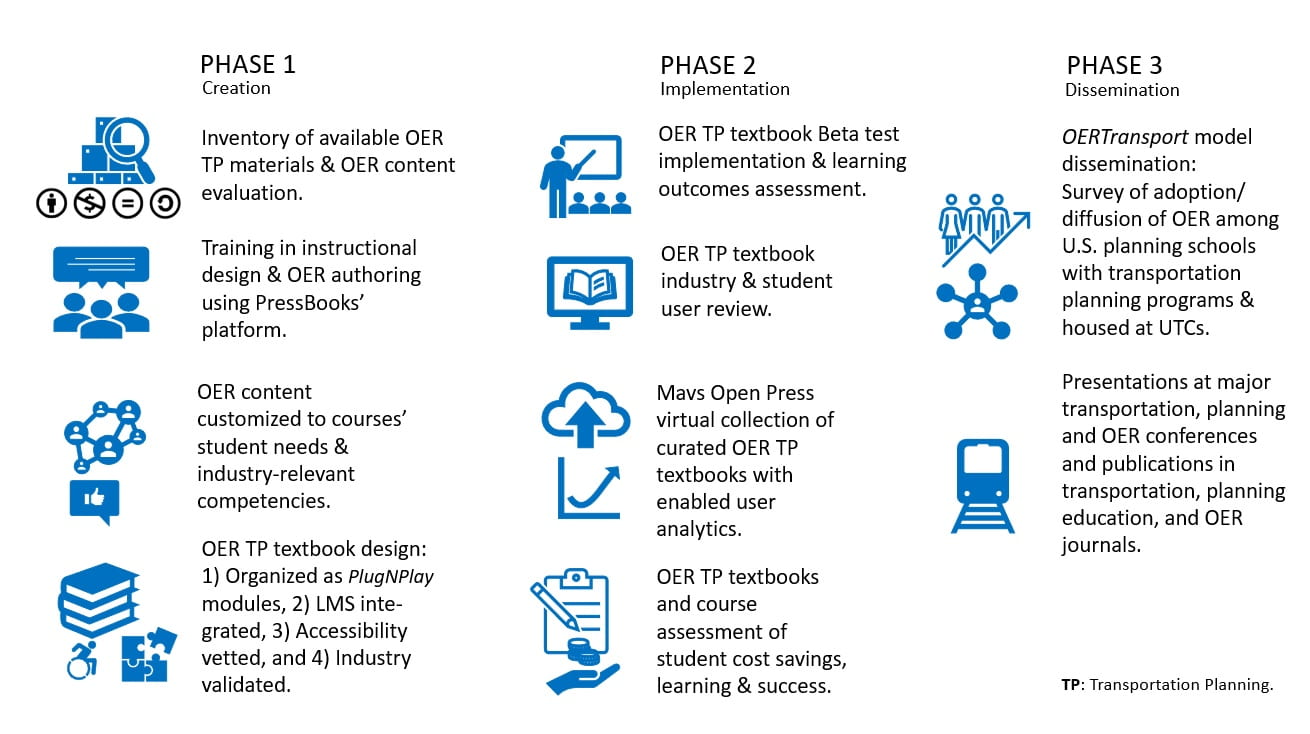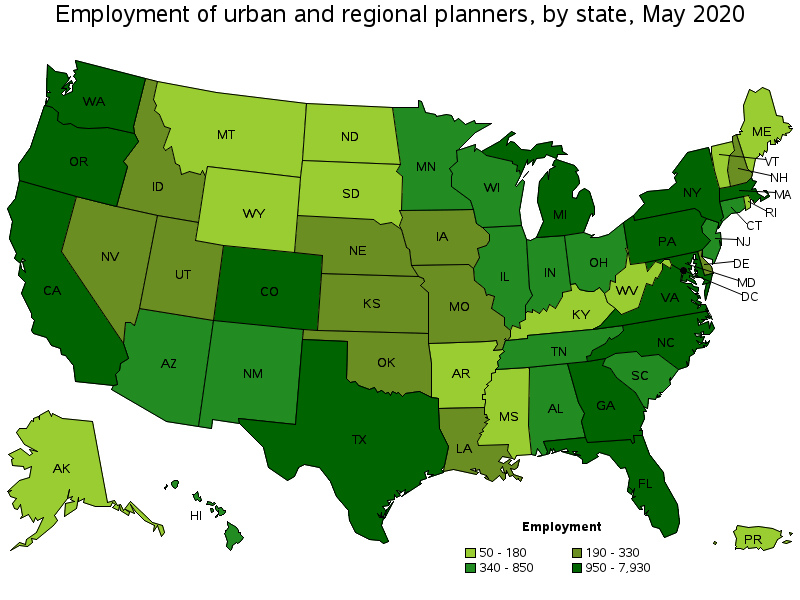About oertransport
WHAT is it?
The Fund for the Improvement of Postsecondary Education (FIPSE) in the U.S. Department of Education awarded in January 2021 an $582,322 Open Textbooks Pilot grant to the University of Texas-Arlington for the three-year project: OERTransport Enabling Transportation Planning Professional Advancement.
WHEN does it begin and end?
The project activities began January 2021 and will end December 2023.
WHY is it important?
Critical need for Transportation Planners
-
-
- A growing need for a diverse transportation workforce and for Diversity, Equity, & Inclusion (DEI) in the transportation industry.
- Employment of Urban & Regional Planners “projected to grow 11 percent from 2019 to 2029, much faster than the average for all occupations” Source: U.S. Bureau of Labor Statistics (2020).
- A post-baccalaureate certificate in Transportation Planning & Policy (TPP) requires a shorter timeframe for placement in the workforce than a traditional master’s degree.
- Vital need for rapid reskilling and upskilling into a high-wage and high-demand occupation.
- OER further reduces cost thus lowering barriers to education and increasing opportunities for a more diverse group of students to become practitioners.
-
Project Details
Consortium Partners: University of Texas-Arlington (UTA), California Polytechnic State University, San Luis Obispo (CalPoly) and the University of South Florida (USF) and each respective institution’s OER libraries and Centers for Teaching and Learning Excellence.
Target Population: students enrolled in the six graduate courses at the consortium universities that will implement the six proposed Transportation Planning open textbooks, which include the core curriculum of a postbaccalaureate certificate in Transportation Planning, a national in-demand occupation.
Activities: The consortium partners, also members of a national university research center led by UTA, collaborate with their respective metropolitan stakeholders, transportation agencies and employers as well as with their open resource libraries and centers for teaching and learning, to accomplish the following project goals:
1) Eliminate textbook costs for select Transportation Planning courses at consortium institutions in Texas, California, and Florida.
2) Expand OER education in Transportation Planning within and beyond consortium institutions.
Project partners will attain these goals through the following objectives and activities:
-
-
-
-
- Develop six industry-vetted transportation planning OER textbooks organized in plugNplay modules that support student personal learning.
- Implement the OER textbooks in transportation planning courses and a postbaccalaureate certificate enhancing student success.
- Build OER instructional capacity beyond the project.
- Scale the OER Transportation Planning model across U.S. transportation planning and urban planning programs.
-
-
-
Anticipated Results:
-
-
-
-
- The total average textbook cost savings resulting from the project’s six OER textbooks implemented at the three institutions will be at least $ 650.81.
- The total textbook cost for students, who enroll in the core courses of the Planning and Policy Certificate implementing the project’s OER textbooks, will be at least 77% less than for students in the same certificate program enrolled in non OER courses using commercial textbooks.
- The average total tuition saving for students who gain marketable transportation planning skills by completing the Transportation Planning and Policy Certificate program rather than a complete master’s degree will be $18,646 for residents and $42,427 for non-residents.
- At least 150 students per year will have enrolled in the graduate courses implementing the Transportation Planning OER textbooks designed under this grant.
- At least 80% of students and instructors using the OER Transportation Planning textbooks developed under this grant will rate these OER materials as “very good”, “good” or “better” in terms of cost, accessibility, and instructional quality compared to previously used textbooks.
- A discoverable collection of OER transportation planning textbooks, including those developed under the grant, will be curated, and housed in the three participant’s OER libraries and shared with major OER repositories. The project’s OERTtransport textbooks will be downloaded at least 300 times by end of 2023 and at least 1,000 every year thereafter.
-
-
-
OERTransport Project Phases
The project follows a three-phase approach of OER creation, implementation, and dissemination.
Phase 1: Development
1. The Inventory of available transportation planning OER is a continuous research process involving:
-
-
-
-
- Finding and selecting OER and evaluating materials for inclusion in the textbook.
- Remixing and customizing OER to course needs by editing content, reordering, and combining with other materials.
- Creating new OER (absent existing content, producing text, photos, videos, and other educational materials).
-
-
-
2. Training in instructional design leveraging Canvas, the learning management system (LMS) in use at the three universities and PressBooks, the OER authoring platform used by UTA MavsOpen Press for OER textbook publishing.
3. Transportation stakeholders’ input. Along with the course’s specific learning objectives, the textbooks must address the knowledge, skills, and technology (KST) deemed indispensable by employers of professional transportation planners. An advisory group, made of employers from the municipal to the regional MPO level drawn from C-TEDD’s consortium’s partners and transportation industry stakeholders, rate the KSTs for inclusion in the six textbooks.
4. OER Textbook modular design consists of building chapters organized as PlugNPlay, stand-alone modules. To be successful in transportation planning, professionals combine an understanding of engineering and technology with planning policies and principles at the intersection of community planning and decision making. The modules or chapters are designed for personalized learning taking advantage of PressBooks H5P tools which enable faculty to produce quizzes and interactive assessments synced to the LMS’s gradebook. In this way, faculty promote personalized learning, and students receive personalized feedback enhancing their learning experience.
PressBooks’ accessibility standards (WCAG 2.0 A & AA guidelines) enable the creation of accessible publications that can be used by all learners. Each textbook undergoes internal and external reviews to ensure the textbook’s content is industry relevant and up to date with current trends in the field.

Phase 2: Implementation. Canvas, the LMS, is the medium of textbook implementation in the classroom. Students engage in coproduction as user reviewers, and the OERTransport advisory team of transportation planners (UTC’s consortium industry partners) has another opportunity to review the OER textbooks. Faculty incorporate final revisions and publish a new edition of the textbook through UTA Mavs Open Press. The OERTransport textbooks form a unique collection of Mavs Open Press publicly accessible and discoverable.
Phase 3: Scale. The OERTransport R&D model of OER textbook development and implementation leverages University Transportation Centers (UTCs) as a national organizational infrastructure for dissemination. The model is scalable via the 24 accredited planning programs with TP curricula housed at similar UTCs across the country.
A national survey of all U.S. accredited urban planning programs offering TP curricula will serve to establish the state of adoption and diffusion of TP OER. This study will help facilitate the spread of information about the OERTransport textbooks model and raise awareness of the need for OER in transportation planning and other planning-related fields.

